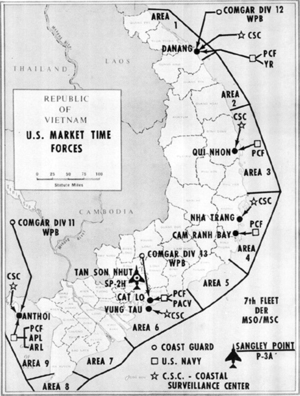| Operation Market Time | |||||
|---|---|---|---|---|---|
 | |||||
| |||||
| Belligerents | |||||
|
|
| ||||
Operation Market Time was the United States Navy, Republic of Vietnam Navy and Royal Australian Navy operation begun in 1965 to stop the flow of troops, war material, and supplies by sea, coast, and rivers, from North Vietnam into parts of South Vietnam during the Vietnam War. Also participating in Operation Market Time were United States Coast Guard's Squadron One and Squadron Three. The U.S. Coast Guard operated, under U.S. Navy command, heavily armed 82-foot (25 m) patrol boats and large cutters armed with 5-inch naval guns, which were used in battle and gunfire support.
Radar picket escort ships, based in Guam or Pearl Harbor, provided long-term presence at sea offshore to guard against trawler infiltration. Originally built for World War II convoy duty, and then modified for distant early warning ("DEW") duty in the North Atlantic, their sea keeping capability made them ideal for long-term presence offshore where they provided support for Patrol Craft Fast (PCF) boats, pilot rescue and sampan inspection. There were two or three on station at all times. Deployments were seven-months duration, with a four- or five-month turn-around in Pearl. When off station, they alternated duty as Taiwan Defense Patrol, with stops in Subic and Sasebo for refit mid-deployment.
Operation Market Time was one of six Navy duties begun after the Tonkin Gulf Incident, along with Operation Sea Dragon, Operation Sealords, Yankee Station, PIRAZ, and naval gunfire support.